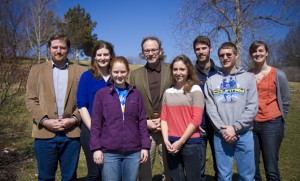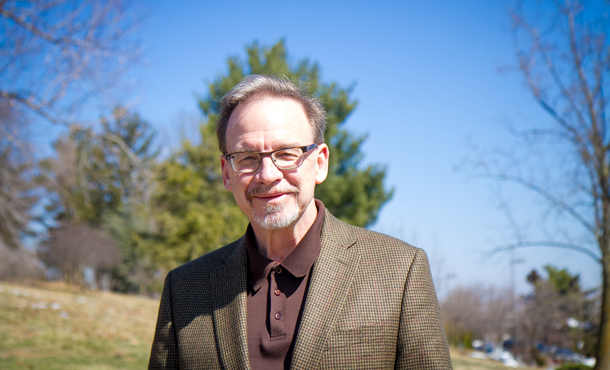Lots of director-level appointees work for the federal government. Of that number, a relatively few have the word Reverend on their business cards, and fewer still – perhaps only one – could identify themselves as an ordained Mennonite minister: David Myers.
Myers, director of the Center for Faith-Based and Neighborhood Partnerships at the Department of Homeland Security, spoke recently to several EMU groups about navigating the tricky divide between church and state in this country.
“There hasn’t been a day in almost five years that I haven’t at least in some way had to negotiate the separation of church and state,” he said. President Obama appointed Myers to his position in 2009.
During the prior 25 years, Myers served faith-based and neighborhood organizations as an executive director and minister, primarily in Chicago. These included Teen Living Programs, Center for Public Ministry and three Mennonite congregations.
In his talk at a seminary chapel (“not a sermon, but a report of an ongoing conversation inside my head and my heart”), Myers told several stories, asking his audience to discern “What belongs to Caesar and what belongs to God?”

Myers began with the seminal Anabaptist story of Conrad Grebel baptizing George Blaurock on a wintery Zurich day in 1525. The two men considered it “an act of faithful discipleship. But to the state and the official church it was an act of heresy and treason. On that day the chains that had bound together church and state for 1300 years were broken.”
Myers makes a “poetic connection” between that story and the First Amendment of the U.S. Constitution, which states that anyone can practice their religion without the intrusion of the state. “That great beautiful river that separates church and state in this country – that river could be understood as beginning on that cold January morning in Zurich in 1525.”
“It is worth thinking about the separation of church and state,” says Myers, “because in a country where so many cultural and religious traditions are observed openly and freely, we, with only a few exceptions, have not had a large scale sectarian war among ourselves.
“Why is it possible to have here, at EMU, an inheritor of the church-state separation tradition, such a robust interfaith conversation?” Myers asks.
Church-state partnerships’ role in disaster relief
In an afternoon talk entitled “Disasters blow down fences and make good neighbors,” Myers said that “the real story after a disaster is the long-term story of linkages and continuing cooperation between organizations who come together in the crucible of rebuilding and recovery.”
Myers contends that in times of disaster, hard-hit communities need the resources of government plus the human presence of voluntary organizations. He called it a “whole community” approach to rebuilding lives as well as houses.
One of Myers’ roles is to put the convening power of a White House official to use in the hours and days following a disaster. “We’re able to bring a wide range of people and organizations into one room, to coordinate efforts, to make connections and get people talking together, sometimes for the first time.”
As communities rally and help descends, Myers notes a window of days or short weeks when fissures are smoothed over. “Unfortunately, those moments often do not last. Social fissures get wider and more pronounced in the long aftermath of disaster.”
Myers appreciates the wide range of faith-based organizations that “pivot toward the disaster. In 2011, after tornadoes left a swath of destruction through Alabama, an Islamic relief group with chainsaws helped clear tangled trees around a trailer home. The elderly woman’s response: ‘I don’t care who is here. I’m just glad that you are.’”
Eastern Mennonite Seminary, the Center for Justice and Peacebuilding, the Center for Interfaith Engagement and the Anabaptist Center for Religion and Society sponsored Myers’ full day of speaking engagements on campus.

I was very impressed with Mr. Myers’ visit. I think he had many important things to say, and I am glad that he’s a part of the community.